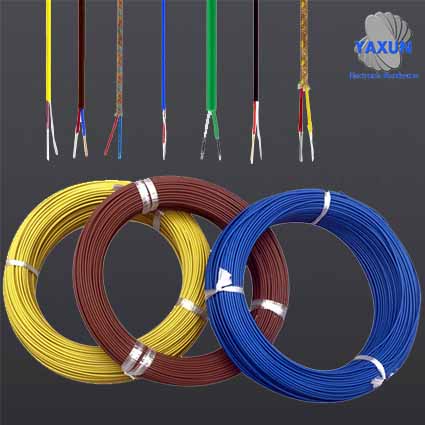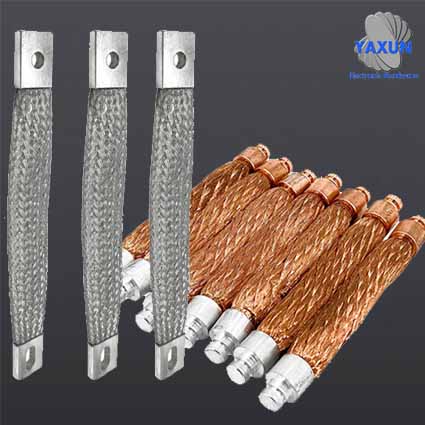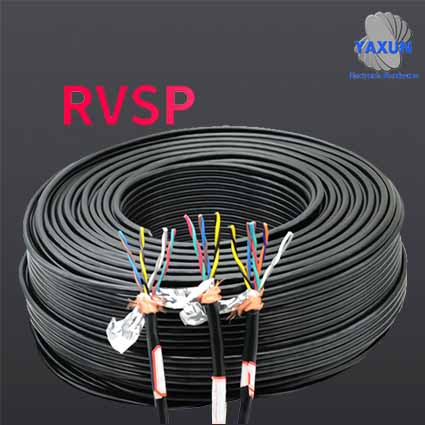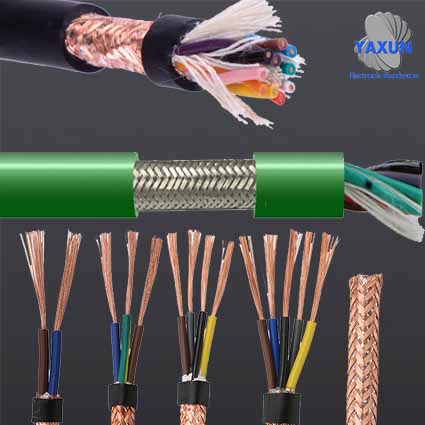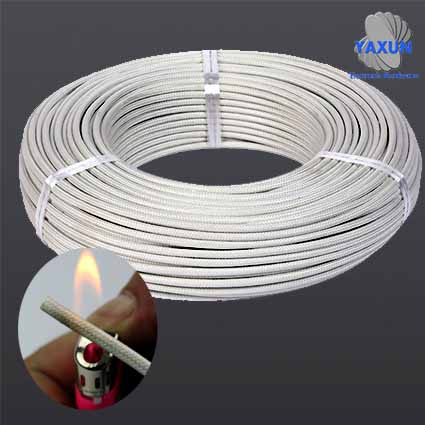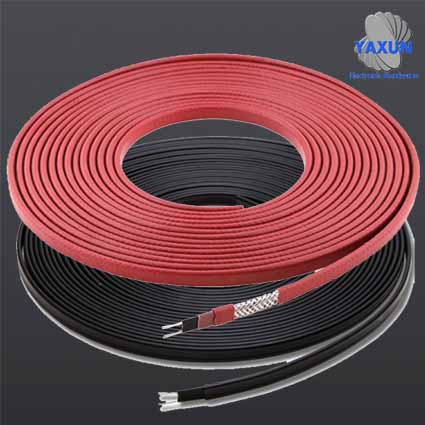China Heating Cable Manufacturing
- PRODUCT DETAIL
What is a heating cable (heating tape)? Function and application of heating cable.
Heating cables (heat tracing, heating tape) have been widely used as an effective pipeline (tank) heat preservation and antifreeze solution. Its working principle is to dissipate a certain amount of heat through the heat tracing medium, and supplement the loss of the heat tracing pipe through direct or indirect heat exchange, so as to meet the normal working requirements of heating, heat preservation or antifreeze. In the 1970s, the American energy industry put forward the idea of replacing steam tracing with cable heating schemes. In the late 1970s and early 1980s, many industrial sectors including the energy industry have widely promoted cable heating technology, replacing steam heating with cable heating. The development of electric heating technology has evolved from the traditional constant power heating to the self-controlled temperature electric heating with conductive plastic as the core.
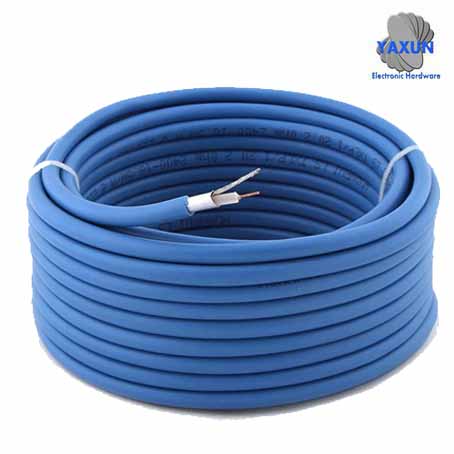
Overview of heating cables
Cable heating is to use the energy of electric heating to supplement the heat lost by the heating body in the process, so as to maintain the most reasonable process temperature of the flowing medium. It is a high-tech product. Electric heat tracing is the uniform heat release along the length of the pipeline or over a large area of the tank volume. It is different from steam tracing where the heat load is highly concentrated on a point or a small area; Electric heating has a small temperature gradient and a long thermal stability time, which is suitable for long-term use. The required heat (electric power) is much lower than electric heating. Electric heating has the advantages of high thermal efficiency, energy saving, simple design, convenient construction and installation, no pollution, long service life, and can realize remote control and automatic control. It is a technology development direction that replaces steam and hot water tracing, and is an energy-saving project to be promoted.Advantages of electric heating cable
Compared with steam (hot water), electric heating cables have many advantages as follows:(1) The electric heating cable is simple, uniform heating, accurate temperature control, remote control, remote control, and automatic management.
(2) The electric heating cable has explosion-proof, all-weather performance, high reliability and long service life.
(3) There is no leakage of the electric heating cable, which is conducive to environmental protection.
(4) Saving steel: it does not require many heat tracing tubes required for steam tracing.
(5) Save insulation materials.
(6) Save water resources, unlike boiler steam that requires a lot of water every day.
(7) Electric heating cables can also solve the difficult problems of steam and hot water heating.
(8) The design work of the electric heating cable is small, the construction is convenient and simple, and the maintenance work is small.
(9) High efficiency, which can greatly reduce energy consumption.
One-time investment, annual operating costs, electric heating cables are less expensive than steam heating cables; In some projects, the one-time investment of electric heating cable may be slightly higher than that of steam hot water heating. But in terms of annual operating costs, usually the cost saved in 1-2 years of electric heat tracing operation can recover the investment.
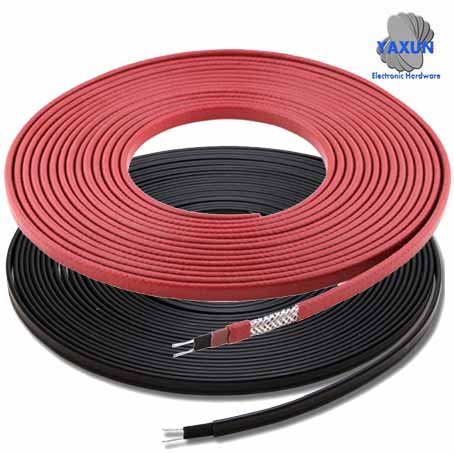
Benefit analysis of using cable heating cable
The self-controlling cable heat tracing adjusts the heat output according to the temperature of the sensitive pipe wall (medium), which is an energy-saving measure. The most widely used self-control temperature electric heating cable consumes 15W of electricity per meter. The total length of the pipeline is 1000m, and the hourly power consumption is 1000×15/1000=15KW/h. When the pipe temperature reaches the upper limit of the maintenance temperature, the heat generation of the cable heating will gradually decrease, and the output power will also decrease, so the power consumption of the electric heating is generally 60% of the rated power; The electricity price is calculated at ¥0.60/KW/h, and the operating day is 100 days (2400 hours), the annual normal electricity consumption cost is: (15×2400)×¥0.60×60%=¥12960. When the self-controlling electric heating belt is used in conjunction with a thermostat, it can not only accurately maintain the medium temperature of the pipe and the heating body, but also greatly reduce the operating cost.The heating value per unit length of the constant power heating belt is constant. The longer the heating belt, the greater the total power output. The most widely used constant power electric heating cable consumes 20W/M. The total length of the pipeline is 1000m, and the electricity consumption per hour is 1000×20/1000=20KW/h. When the temperature of the pipeline reaches the upper limit of the maintenance temperature, the output power will then become stable, so that the power consumption of the electric heating remains unchanged; The electricity price is calculated at ¥0.60/KW/h, and the operating day is 100 days (2400 hours), the annual normal electricity consumption cost is: (20×2400) × ¥0.60=¥28800. When the constant-power electric heating belt is used in conjunction with a thermostat, it can also accurately maintain the medium temperature of the pipe and the heating body.
Service life of electric heating cable
Under proper maintenance, the service life of the electric heating cable system is 8 years or longer.Application range of electric heating cable products
Electric tracing cable products can be widely used for heat tracing, antifreeze and anti-condensation of pipelines, pump bodies, valves, tanks and tank volumes in petroleum, chemical, electric power, medicine, machinery, food, shipping and other industries. It is the most advanced and effective method for maintaining the temperature of the infusion pipeline and the tank of the liquid storage medium. Electric heating is not only suitable for various places of steam heating, but also can solve the difficult problems of steam heating, such as: Heat tracing for long-distance pipelines, heat tracing in narrow spaces; Irregular appearance equipment (such as pumps) heat tracing; No steam, heat source or heat tracing for pipelines and equipment in remote areas; Heat tracing of plastic and non-metallic pipes, etc.Classification of commonly used electric heating cables
Commonly used electric heating cables can be divided into the following types for different pipelines (tanks):1. Self-limiting temperature (self-controlling temperature) electric heating cable: With the increase of temperature, the resistance of this heating tape becomes larger and the power becomes smaller. Because of the large current when it starts, the length of use is generally not more than 100 meters, and the heating tape can be cut at will. No matter how long the heating belt is, it can generate heat when connected to the rated voltage.
2. Parallel electric heating cable: Two (or three) parallel insulated copper stranded wires of this heating belt are used as power busbars. The PTC characteristic heating wire is wound on the skeleton, and every other heating section length is alternately connected to the bus bar to form a continuous parallel resistance. The length of this heating belt is about 10-800 meters.
3. Series electric heating cable: This electric heating belt uses three parallel insulated copper stranded wires with the same cross-sectional area and a certain length as the power bus bar and the heating core wire. Reliably short-circuit one end, and connect the other end to a 380V (or designed voltage) power supply to form a star load. According to Joule-Lenz's law: Q=0.24IRT electric energy is transformed into thermal energy. The star-shaped load continuously emits heat, forming a continuous and uniform heating cable. According to actual needs, the three-phase (single-phase) of the electric heating cable can be separated (split) or integrated into one. The length of the heating tape should not be too short, generally about 500-2500 meters.
4. High temperature electric heating cable: This heating tape is made of glass fiber or other high temperature resistant materials, and the temperature resistance is within 300℃. The length ranges from 1-50 meters (because it cannot be cut at will, you need to find a professional manufacturer to design).
6. MI cable:
This heating tape is composed of a metal core (heating element), a mineral magnesia (insulating layer) and a metal tube (usually copper, steel or stainless steel, etc.) that has been drawn many times around the core. The continuous working temperature can reach 250-590℃, and the short-term working temperature can reach 1083℃, making the length 18-680 meters (because it cannot be cut at will, it needs to be designed by a professional manufacturer).
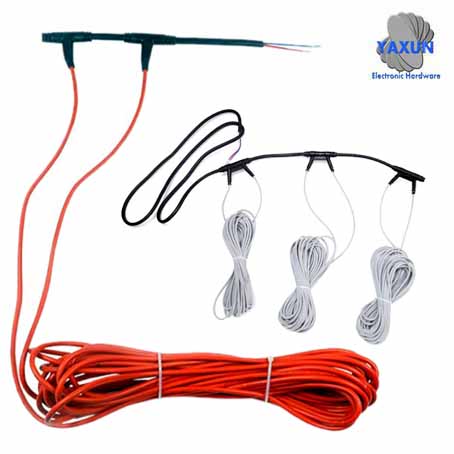
Selection of electric heating cable
How to choose electric heating cables in actual projects requires specific analysis of specific conditions. It is not suitable to divide by electric heating zone. Both are selected from constant power electric heating cables, or both are selected from temperature-controlled electric heating cables. To comprehensively consider from a technical and economic point of view, it is recommended to refer to the following selection principles.(1) In the oil and gas separation zone composed of gas separation buffer tanks and natural gas separators, surface oil pipelines, oil and gas separation buffer tank blowdown pipelines, natural gas separators, and level gauges are relatively concentrated. The temperature control is also strict, and constant power electric heating cables can be used. Among them, the level gauge adopts single-phase constant power electric heating cable. Others use three-phase constant power electric heating cable. In this way, a set of explosion-proof distribution boxes and thermostats can be used for unified control, but the distribution boxes, junction boxes, and thermostats must meet the explosion-proof requirements.
(2) The water supply tank and water supply pipeline are generally far away from the explosion-proof area, the heated body is not too concentrated, and the temperature control requirements are not high. As long as the water temperature is always maintained within a certain range, the design requirements can be met. Therefore, if the self-controlled temperature electric heating cable is used, electric heating accessories such as distribution boxes and thermostats can be omitted.
(3) In areas with many valve elbows, cross-overlap installation may occur, so it is not suitable to install constant-power electric heating cables (with a separate electric heating wire layer). Optional self-control temperature electric heating cable.
(4) From the perspective of design and installation, constant power electric heating cables are generally limited by the length of the nodes. If the exact length node cannot be found during cutting, this part of the heating tape will not work. This not only affects the heat tracing effect of the pipeline, but also causes waste;
The self-control temperature electric heating cable can be cut at will to ensure the complete electric heating.
Simple test method for temperature control heating cable
According to the IEC1423 standard, the following simple test methods are recommended to the majority of users:1. Starting current (is)
Equipment: multimeter, power supply, socket (preferably with switch), temperature tester
Test steps:
(1) Take a 1 meter long heat tracing cable (take 3-4 cm as the wire end), cover one end of the cable with insulating tape, and strip the wire at one end and insert it into the socket.
(2) Connect a multimeter in series on the line and set it to (A-)10A gear.
(3) Turn on the power supply and read the instantaneous maximum current value, that is, the cable is in the air under the current temperature environment.
2. Nominal power:
Equipment: multimeter, power supply, socket (preferably with switch), temperature tester, stainless steel water cup, insulation material
(1) Take a 1 meter long cable (take 3-4 cm as the thread end), and the connection method is the same as above.
(2) Fill the water cup with water, wrap the cable around the water cup and keep it warm, so that the temperature of the system remains unchanged for 5 minutes after the cable is energized.
(3) Turn on the power supply, read the steady-state current value (that is, the current value remains unchanged), record the temperature, and measure the power supply voltage.
(4) Calculated power: P=UI (unit W/M)
The above method is simple and easy to do, but it is not accurate and is for reference only. However, under the same temperature and environmental conditions, different manufacturers, the same specifications, and the same power heating belts can be compared.
3. Insulation resistance
Take a 3 meter long cable and measure it with a DC, 2.5KV megohmmeter. Cables without metal braiding should be immersed in water during the test. Voltage should be applied between the two conductors, and the megohmmeter should be shaken evenly for 1 minute before reading. Insulation resistance is not less than 500ΩM
Heating method of electric heating cable
1. The core material of the self-controlling electric heating cable is PTC semi-conductive plastic. Its resistance value increases correspondingly with the increase of temperature, but when the temperature rises to a certain value (the temperature value can be adjusted according to needs), the resistance suddenly increases, thereby blocking the current and stopping heating; When the temperature is lower than the threshold temperature, the resistance of the PTC material will automatically decrease the conduction current and continue heating. So that the system maintains a stable temperature value. The basic self-regulating electric heating cable (heating cable) is composed of PTC core tape and insulation layer. The PTC material is uniformly and continuously extruded (or wound) on the parallel metal core (also known as the bus bar), and the flat belt made is the PTC core belt. Wrap a layer of polyethylene polymer or polyvinyl chloride insulating layer on his outside. And when the environment requires strengthening or corrosion resistance, a braided layer or fluoropolymer cover can be added. When the two conductive bus bars at one end of the core belt are connected to the power supply, the current flows laterally from one bus bar through the parallel PTC material layer to the other bus bar, forming a parallel loop. A certain length of core tape has a certain resistance at a certain temperature and has PTC characteristics. When current flows through the parallel PTC material layers, Joule heat is generated, which causes the core belt to heat up. At the same time, the heat of the core belt is transferred to the low-temperature heated body through the cable insulation layer to compensate for the heat lost by the system to the environment.2. The power output of the constant power electric tracing cable is always constant after power-on, and will not change with the external environment, heat preservation material, and heat tracing material changes. The output or stop of its power is usually controlled by a temperature sensor.
A: The resistance wire of the parallel constant power electric tracing cable is connected in parallel, and the pipe is heated by the heating of the resistance wire when it works.
Principle: Two parallel nickel-copper stranded wires are wrapped in a fluoride insulation layer. As the power bus, and the inner heat insulation layer is wound with nickel-chromium alloy heating wires, the heating wires are welded at regular intervals to form a continuous parallel resistance. When the copper bus bar of the power supply is energized, the parallel resistors will heat up, forming a continuous heating electric belt, which can be cut arbitrarily.
B: The resistance wire of the series constant power electric tracing cable is connected in series, and the pipeline is heated by the resistance wire when it is working.
Principle: The series electric heating cable is made of insulated copper stranded wire as the power bus, which is the heating core wire. The core wire with a certain internal resistance will generate Joule heat when passing the current core wire (Joule-Lenz's law Q=0.24I\S2^; Rt). Its size is proportional to the square of the current, the resistance of the core wire and the passage time. Therefore, the series electric heating cable continuously emits heat with the continuation of the power-on time, forming a continuous and uniform electric heating cable. The core wire current and resistance of the series electric heating cable are the same, so the whole electric heating cable heats evenly from the end to the end, and its output power is constant regardless of the ambient temperature and pipeline temperature.
3. Mineral insulated heating cable is a special heating cable with metal as outer sheath, electric heating material as heating element, and magnesium oxide powder as insulation. The heat generation of mineral insulated heating cables is related to the working voltage, the cross section of the heating core and the length of the cable.

